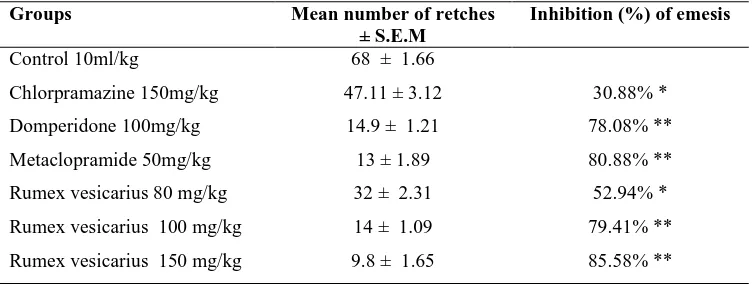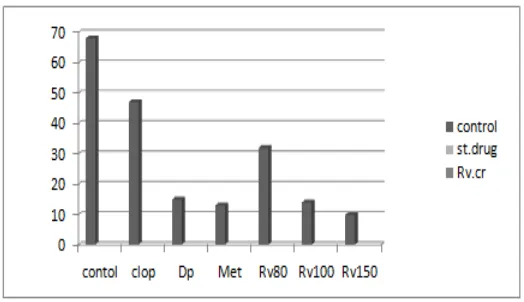Volume 2, issue 4 (2013),33-37
International Journal of Pharmaceutical Research &
Allied Sciences
33
Antiemetic Activity of Methanolic Leaf Extract of Rumex Vesicarius
Linn
Imran Ahmad Khan1*, Abdul Aziz2, Shaukat Hussain Munawar3, Zahid Munzoor4 1,2Faculty of Pharmacy, Bahauddin Zakariya University, Multan, Pakistan
3, 4 Faculty of Veterinary, University of Agriculture, Faisalabad, Pakistan imranahmadkhandurrani@gmail.com
Subject: Pharmacology
Abstract
Crude methanol extract of the leaves of Rumex vesicarius L. was evaluated for anti-emetic activity. Emesis was induced by the oral administration of copper sulphate 50mg/kg body weight to male chicks of four days age. The anti-emetic activity was determined by calculating the mean decrease in number of retching in contrast with those of control. Rumex vesicarius (150, 100 and 80 mg / kg body weight orally) showed anti-emetic activity when compared with standard drugs Chlorpromazine, Domperidone and Metoclopramide at the same dose. All the extracts, showed the antiemetic activity. Highest (85.58% inhibition) and the lowest (52. 94 % inhibition) respectively
Keywords:
Antiemetic, Rumex vesicarius, chi-ck emesis model, Domperidone, Metoclopramide, ChlorpromazineIntroduction
Nausea and vomiting induced by several cancer chemotherapy agents is often the most distressing side effect of treatment. The mechanisms are quite complex. The Vomiting center in the reticular formation can be stimulated by either afferent stimuli from the gastrointestinal tract or by the chemoreceptor trigger zone (CTZ). The latter is probably the primary site for emetic activity of most cancer chemotherapeutic agents and is accessible to drugs that do not cross the blood-brain barrier. It is quite possible that several agents have different receptors. The wide spectrum of antiemetic is in contrast to the often observed lack of effectiveness.
Rumex vesicarius Linn., (Family: Polygonaceae)
known as “Bladder dock” or “Chukkakura” is an annual, glabrous herb, 15-30 cm in height, branched from the root, with long, elliptic, ovate or oblong leaves and monoecious flowers. Rumex vesicarius
Lin. has been used traditionally for ally pain of
toothache, as astringent, for nausea, as appetizer, cooling agent, anti venom, insect bite, seeds were
used for dysentery (Dymoke, 1972).
In ayurvadic system of medication, it was use as laxative, stomachic, heart troubles, analgesic, anti tumor, flatulence, spleen disease high cough, asthma, bronchitis, dyspepsia, vomiting, alcoholism, biliousness (Kirtikar and Basu, 1987) In unani system of medication, it was used as tonic, analgesic, cooling
agent, for scabies, leucoderma, nausea, diuretic .astringent (kirtikar and Basu, 1987). In other folk medicines it was used as to eradicate constipation, hiccup, piles, diuretic, antioxidant, (Hariparasad 2011). Reptile insect, depurative, sedative, somatic, hepatoprotective, dysmenorrhoea, blood purifier, diarrhea, alkaylity, vomiting, dyspepsia, chronic catarrh, urinary affection ,renal disorders, bloody dysentery, coronary heart diseases (Madhavashetty et al., 2008) antiviral, rectal prolapsus, antidiabetic, leucoderma, lymphatic glyndular system disease, calculus, antispasmopic, anticholisterol, carbubuncles, impetigo, epphrodiasic (Nardkarnis, 2008; Pullaiah and Ali, 1999).
In the present study, we report the antiemetic activity of aqueous- methanolic extract of leaves of Rumex
vesicarius.
Material and Method
Material
Chemicals
34
Metoclopramide and Domperidone were purchased from Hinoon pharmaceuticals Pvt. Ltd Lahore, Pakistan.
Animals
Young male chicks, 4 days of age, weighing from 32-48 gm were obtained from Al madina poultry Traders Multan. After 24 hrs fasting, the antiemetic activity was evaluated. All chicks were kept under laboratory conditions at room temperature with 12h light and dark cycles. All animal experiments were carried out in accordance with the acts of the Animal Ethical Committee of Baha-uddin zakariya university,Multan,Pakistan.
Method
Collection of Plant Materials
Indigenous medicinal plant Rumex vesicarius, L. known by a local name of Khat palak The plant were collected from the Mondka Shahlamal District Muzaffar Garh, Pakistan. The plant material was authenticated by expert taxonomist, Professor Dr. Altaf Dasti at the Institute of Pure and Applied Biology, Bahauddin Zakariya University, Multan, Pakistan (voucher F.P.ST-215) .
Crude extract
The plant material was made free from foreign adulterants and vegetative debris by hand picking and leaves were detached from the plant. Washed and shade dried. Within 8 days leaves became crispy. Special electrical herbal Grinder was used to form coarse powder. Uniform dark green powder was obtained with characteristic smell.
The powdered plant material (1 kg) was subjected to
maceration in 70% methanol in Amber coloured glass bottle at room temperature for 8 days with occasional shaking (Harborne, 1973). The soaked material was passed through muslin cloth to remove the Vegetative material and the fluid obtained was filtered through Whattman-1 Filter paper. The filtrate was evaporated on a rotary evaporator (Rotavapor, BUCHI labrotechnik AG, Model 9230, Switzerland) at 37ºC under reduced pressure to thick paste like consistency (approximate yield was 11%)
and the extract obtained was stored at -4°C in air tight jars in lab refrigerator.
Antiemetic activity
The anti emetic activity was evaluated with slight modification by using chick emesis model(Akita et al., 1998). Each chick was placed in a large beaker and left to settle for 10 minutes. The methanol extracts of Rumex vesicaruis., leaves were prepared as a dose of 150.100 and 50 mg/kg body weight in a volume of 10 ml/kg in 0.9% saline containing 5% DMSO and 1% Tween 80. The dose was administered abdominally. The control group received only saline 0.9%. After 10 minutes, copper sulfate was administered orally at 50 mg/kg b.w., and the number of retches was observed during the next 10 minutes. Domperidone, Metoclopramide and Chlorpromazine was used as a standard antiemetic drug (150 mg/kg body weight). The percent inhibition was calculated by the following formula:
Inhibition (%) = (A-B/A) x 100
Where, A = Frequency of retching in control group;
and B = Frequency of retching in test group
Phytochemical Study
The crude plant extracts were initially screened qualitatively with different organic solvents and reagents to detect the presence of some phytochemicals classes (Tona et al., 1998).
Statistical analysis
Value for antiemetic activity is expressed as mean S.E.M. The statistical significance of the difference is determined by an unpaired Student’s t-test. P values of < 0.05 were considered significant and < 0.01 were highly significant.
Results
Preliminary phytochemical screening detected presence of tannins, phenols, saponins, anthraquinones and coumarins as constituents of the crude aqueous-methanolic extract of Rumex
vesicarius (Rv.cr) while it tested negative for the
35
Table 1: Pytochemical analysis of Rumex vesicarius (leaf) crude extracts (Rv.Cr).
Sr.no Test Observations Result
1 Alkaloid No ppt Negative
2 Saponins 1cm froth Positive
3 Tannins Light purple Positive
4 Anthraquinones Pink Positive
5 Coumarins Yellow fluorescence Positive
6 Phenols Light purple Positive
7 Flavanoid Light yellow colour Positive
Results of the antiemetic activity of methanol extracts of Rumex vesicarius leaves at various concentrations are given in Table 2. All the extracts inhibited emesis to an extent greater than chlorpromazine at a dose of 150 mg/kg. At test dose of 100mg/kg Rumex
vesicarius showed almost similar activity as
reference drugs, Metaclopramide and Domperidone. At test dose of 150mg/kg Rumex vesicarius showed more antiemetic activity than all reference drugs were
used. Highest antiemetic activity showed by Rumex
vesicarius L. (85.58 % inhibition) and the lowest
antiemetic activity showed (52.94 % inhibition. From results Figure 1, it is clear that all tested extracts concentrations of methanolic leaf extract of Rumex
vesicarius having antiemetic potential which are
comparable to chlorpromazine, metaclopramide and domperidone.
Table 2: Antiemetic activity of methanolic leaf extracts of Rumex vesicarius L. S.E.M. = Standard Error of
Mean, *P <0.1 and **P<0.005 vs. control showing significant and most significant values using unpaired
Student’s t-test
Groups Mean number of retches
± S.E.M
Inhibition (%) of emesis
Control 10ml/kg 68 ± 1.66
Chlorpramazine 150mg/kg 47.11 ± 3.12 30.88% *
Domperidone 100mg/kg 14.9 ± 1.21 78.08% **
Metaclopramide 50mg/kg 13 ± 1.89 80.88% **
Rumex vesicarius 80 mg/kg 32 ± 2.31 52.94% *
Rumex vesicarius 100 mg/kg 14 ± 1.09 79.41% **
36
Clop=chlorpromazine, Dp= Domperidone, Met=Metaclopramide. RV= Rumex vesicrius
Fig. 1: Antiemetic effect, Group-I: Control (Normal saline solution); Group-II: Slandered drugs (Chlorpromazine, Metaclopramide and Domperidone); Group-III; Rumex vesicarius L. (80mg/kg, 100mg/kg
and 150mg/kg).
Discussion
On the basis of these results it may be concluded that all the extracts have anti-emetic potential and are comparable with that of chlorpromazine, metoclopramide and domperidone (the reference drugs). Although the results are significant but the mode of action is not exactly known. However, proposed mechanisms are, as the oral copper sulphate induces emesis by peripheral action (Hossein et al., 2005) and the extracts were able to effectively prevent its effect, it could be implied that these extracts have a peripheral anti-emetic action,
Rumex vesicaeius L. contains flavonoids, and
terpenes (Hariparasad,2011 ) which are reported as active principles against emesis in chick emesis model (Kinoshita et al., 1996). Hypercalicemia metabolic disturbance of both stomach and part of brain that coordinates vomiting, methanolic leaf extract of Rumex showed calcium channel blocking mechanism in spasmolytic activity (Khan, 2013) Therefore, it may be said that one of them may be involved in the antiemetic activity of Rumex
vesicarius leaf extract.
Further studies are required regarding the exact mechanism of action responsible for antiemetic activity of Rumex vesicarius. Claims of alkaloidal responsibility as antiemetic constituent (Hassan et al., 2012) is ruled out as Rumex vesicarius is deprived of alkaloidal constituent (Hariparasad, 2011).
Conclusion
From the present investigation it was clear that the
Rumex vesicarius L.methanolic leaf extract posse’s
excellent antiemetic activity. Others factors such as the age and stimuli affected the degree of antiemetic activity.
Acknowledgement
Author thankful to Al madina poultry traders for providing the animal model
“Cite this article”
I. A. Khan, A. Aziz, S. H. Munawar, Z. Munzoor “Antiemetic Activity of Methanolic Leaf Extract of Rumex Vesicarius Linn” Int. J. of Pharm. Res. & All. Sci.2013; Volume 2, Issue 4, 33-37
Reference
(1) Dymoke W. Pharmacographia Indica: A History
of the Principal Drugs of the Vegetable Origin.
Karachi (Pakistan): The Institute of Health and Tibbi Research, Hamdard; 1972: p 2114.
(2) Kiritikar KR., Basu BD. Indian Medicinal plants. Vol III , 2nd ed. Dehradun, India: popular publishers; 1987: pp. 1961-1963, 1023-1028. (3) Hariprasad PS, phytochemical screening and
37
L, International journal of pharmTech research, 2011; vol 3: p 1078-1082
(4) Madhavashetty K, Shivaji K, Tulasirao K. Flowering plants of chittor district, Andhra pradesh, India. 2 nd edition., Students offset printers; 2008: pp 298.
(5) Nardkarnis KM. Indian materia medica. Vol 1. Popular prakashan pvt.ltd; 2002: pp 1080-1081. (6) Pullaiah T, Ali MD, Flora of Andhra Pradesh (
India ). Vol 2., Scientific Publishers; 1997: pp 817.
(7) Harborne JB, Methods of plant analysis.In, Phytochemical Methods. Champan and Hall, London, 1973; pp. 1-7.
(8) Akita Y, Yang Y, Kawai T, Kinoshita K, Koyama K, Takahashi K, New assay Method for surveying antiemetic compounds from natural sources, Journal of Natural Products, 1998; vol 4: p 72- 77.
(9) Tona L, Kambu K, Ngimbi N, Cimanga K, Vlietink AJ, Antiamoebic and Phytochemical Screening of Some Congolese Medicinal Plants, Planta Med, 1998; 61 (1): 57-65.
(10) Hossein H, Mashallah M, Akbar G. Antiemetic effect of Mentha xpiperita aerial parts extracts in young chickens. Iranian Journal of Pharmaceutical Sciences 2005; vol 1: p 21-24.
(11) Kinoshita K, Kawai T, Imaizumi T, Akita Y,
Koyama K, Takahashi K, Anti emetic principles of Inula linariaefolia flowers and
Forsythia suspense fruits, Phytomedicine, 1996;
vol 3: p 51-58
(12) Khan IA, spasmogenic and spasmolytic activity of methanolic leaf extract of Rumex vesicarius L, Sci.Int (Lahore), 2013; vol 25(2): p 291-294.
(13) Hassan MM, Azhar A, Salman A, Ahmad SW, Antiemetic activity of some leguminous plants. Pakj.Bot, 2012; vol 44(1): p 389-391.

